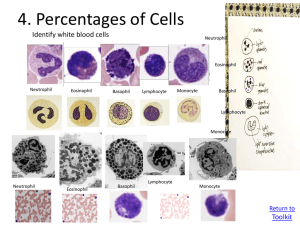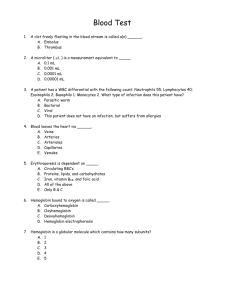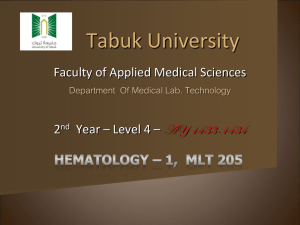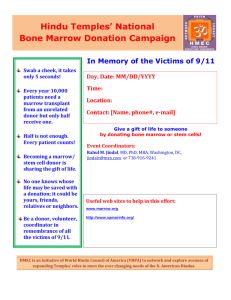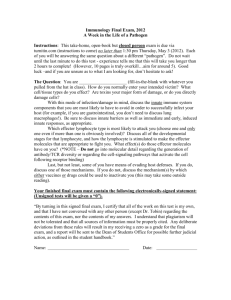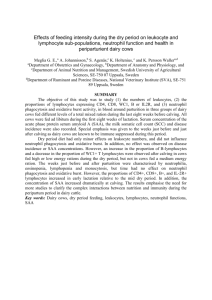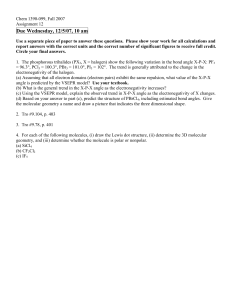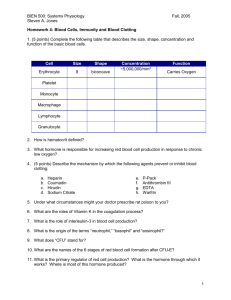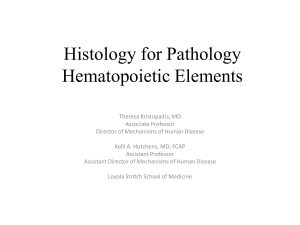Nervous * Day 1 Quiz
advertisement
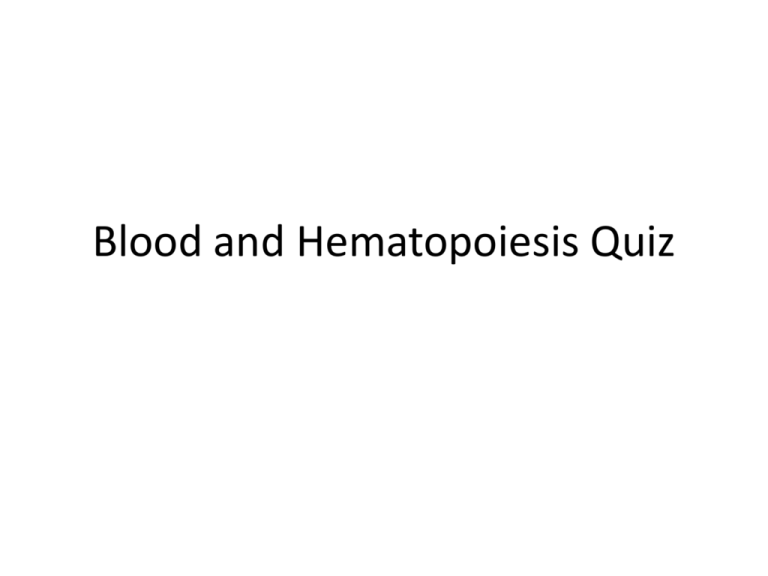
Blood and Hematopoiesis Quiz ResponseWare Login ResponseWare Web Web Address: http://www.rwpoll.com/ Session ID: 752003 ResponseCard RF Channels: NA ResponseWare App Not Enabled 1. Reticulocytes may be identified by light microscopy due to their containing basophilic remnants of Amino acids DNA Lipids RNA Sugars 40% 33% 20% 7% in s RN A id s Lip DN A Su ga r o ac id s 0% Am A. B. C. D. E. 2. As the last step in neutrophilic granulocytopoiesis, g. .. ... lic op hi Eo sin on ob l as ts at ho c Or t M hr om ll n ce di v op .. . . uc l.. ... E. 10% 3% ul D. 17% 14% Ba nd C. 55% en -st im B. Antigen-stimulated monocytes differentiate into plasma cells Band cell nuclei will begin to become segmented Orthochromatophylic eryhtroblasts divide to form reticulocytes Monoblasts divide to form lymphocytes Eosinophilic granules are produced An tig A. 3. Hereditary spherocytosis is a condition which involves a defect in a cytoskeletal protein of the erythrocyte, causing an abnormal spherical cell shape. This protein is Albumin Band 3 protein Hemoglobin Spectrin P-selectin 94% 6% in le ct Pse ct r in 0% Sp e og l ob in 0% He m Ba nd 3 pr ot ei n um in 0% Al b A. B. C. D. E. 4. One function of the helper T lymphocytes is to stimulate B lymphocytes to undergo mitosis and subsequent differentiation into Antibodies Antigens Cytotoxic cells Natural killer cells Plasma cells 77% 11% lls ce sm a Pl a Na t ur a lk ill er ... ce ll. .. en s Cy to to xic An tig s od ie 8% 4% 0% An tib A. B. C. D. E. 5. The predominant component(s) of blood plasma, making up roughly 90% of its weight is/are Albumin Neutrophils Protein Solutes Water 84% 14% er W at ut e s 0% So l in 0% Pr ot e ph i tro Ne u um in ls 2% Al b A. B. C. D. E. 6. The predominant protein(s) in blood plasma is/are Albumins Fibrinogens Globulins Hemoglobin Red blood cells 94% 0% od bl o d Re He m og l ce ll. .. ob in s lin Gl ob u Fib r in og e ns s in um 4% 2% 0% Al b A. B. C. D. E. 7. The predominant cell type(s) in blood is/are Leukocytes Lymphocytes Neutrophils Platelets Red blood cells 85% 7% 6% ce ll. .. le ts te Re d bl o od Pl a Ne u tro ph i ls es 0% ph oc yt Ly m oc y te s 2% Le uk A. B. C. D. E. 8. The predominant leukocytic cell type in blood is/are Basophils Lymphocytes Monocytes Neutrophils T cells 94% el ls ph i tro Ne u ls 0% te s on oc y M Ly m ph oc yt es ils 2% Tc 4% 0% Ba so ph A. B. C. D. E. 9. The agranulocyte lineage of leukocytes contains the lymphocytes and what other cell type? Erythrocytes Macrophages Megakaryocytes Monocytes Neutrophils 72% 12% 12% M Ne u tro ph i ls te s 0% on oc y M eg ak ar yo cy te s ge s ph a M ac ro th r oc yt es 5% Er y A. B. C. D. E. 10. Senescence of red blood cells is a process in which aged cells are destroyed by macrophages. The Band 3 protein involved in this process is actually a type of A. Chloride channel B. Cytoskeletal filament C. Platelet D. Stereocilia E. Tight junction 72% 16% 6% 6% tio n ia ju nc oc il Ti gh t re St e te le t Pl a le ta lf .. . Cy to sk e Ch l or id e ch an n. .. 0% 11. What is the most common human hemoglobin type? 88% 11% 0% Hb S 0% Hb H Hb F 2% Hb A2 HbA HbA2 HbF HbH HbS Hb A A. B. C. D. E. 12. Erythrocyte senesence ultimately leads to destruction by macrophages predominantly in which organ ? Liver Lymph nodes Spleen Thymus Yellow bone marrow 85% 13% Ye llo m a. .. 0% bo ne w Th ym us ee n 0% Sp l no de s Ly m ph er 2% Liv A. B. C. D. E. 13. The typical lifespan of a circulating erythrocyte is 1-2 hours 2 days 120 days 2 weeks 2 years 78% 11% 5% 5% rs ea 2y ee ks 2w s da y 12 0 ay s 2d ho ur s 0% 12 A. B. C. D. E. 13. Of the 4 common, human blood types, Type O is unique in that an individual possesses red blood cells with no A or B antigens and A. Both A and B antibodies B. No A or B antibodies C. Only A antibodies D. Only B antibodies E. Only C antibodies 83% 15% 0% 2% s an t ib od On ie ly s C an tib od ie s od ie yB yA On l an tib od i tib On l A No Bo th A an d B or B an an tib od ie s es 0% 15. Neutrophils are motile cells. Microtubules play an important role in this locomotion ability along with A. Actin and myosin B. Large cell size C. Non-staining granules D. Prolonged lifespan E. Segmentation of their nuclei 88% 2% 6% o. .. .. 0% n tio en ta m Se g ng ed lif e. ... Pr ol o ng g No ns ta i ni ll s ce ge La r Ac t in an d m yo s.. . iz. .. 4% 16. Eosinophil specific granules stain eosinophilic giving the cell its characteristic red color. The predominant protein in the eosinophil specific granule is Collagen Collagenase Hemoglobin Keratin Major basic protein 62% 19% 13% pr ... t in aj or ba sic M Ke ra ob in 2% og l He m Co l lag lag en a en se 4% Co l A. B. C. D. E. 17. Basophils are functionally similar to mast cells in that they secrete granules containing similar protein content, notably A. Antibodies B. Collagenase C. Heparin and Histamine D. Major basic protein E. P-selectin 94% Hi st an d in He pa r in le ct en lag Co l Pse s od ie An tib 2% 0% am M aj in or e ba sic pr ot ei n 2% as e 2% 18. Humoral immunity is mediated by B cells which upon activation by antigen recognition differentiate into a cell capable of producing antibodies, the B cell Macrophage Natural Killer cell Plasma cell T cell 68% 15% a sm Pl a el l ll ce ... er lK ur a Na t ac ro M 5% ill ph a ce ge ll 5% Tc 7% B A. B. C. D. E. 19. Cell-mediated immunity is a function of many cells including T cells. A T cell which directly acts to kill cells expressing foreign antigens on their surface is termed 83% 8% es so r ur a l 0% Na t M em or y 2% Su pp r 8% He lp er Cytotoxic Helper Memory Natural Suppressor Cy to to xic A. B. C. D. E. 20. Memory B cells derive from a naïve B cells initial exposure to a foreign antigen. What is true of the immune response of a memory B cell after a second exposure to that antigen? It doesn’t occur It involves the CNS It is larger in scope It is slower It is smaller 91% 6% le r al ss m It i It i ss lo w i. . . ar sl It i 0% er 0% ge r th . .. ve s nv ol It i oe s n’ to cc ... 3% It d A. B. C. D. E. 21. Platelets are cell fragments that derive from which cell type? Megakaryocytes Monocytes Osteocytes Plasma cells T lymphocytes 94% a sm Pl a ym ph oc y Tl s cy te 2% te s 0% ce lls 0% Os te o te s on oc y M eg ak ar yo cy te s 4% M A. B. C. D. E. 22. Platelets contain structures called granulomeres that contain numerous proteins. A key protein in the granulomere is a growth factor important in blood vessel growth and regeneration, and is named 56% 20% 12% Pe rfo t in le c Pse rin 7% 5% M aj or hi st Le oc ct Pl o in at m el p at et ib -d ili er t.. iv . ed gr ow th ... A. Leptin B. Major histocompatibility complex C. Platelet-derived growth factor D. P-selectin E. Perforin 23. Platelets possess contractile activity, and play an important role in repairs to blood vessels. This contractile activity in platelets is mediated in part by A. Actin and myosin B. Demarcation membranes C. Granulomeres D. Megakaryocytopoiesis E. Smooth muscle 71% 17% 7% M us c le m ... Sm oo th eg ak ar yo cy to p er e s 0% lo m e. Gr an u m n tio De m ar ca Ac t in an d m yo s.. . .. 5% 24. Inactive marrow that functions primarily to store fat is termed Multilocular Red Unilocular White Yellow 89% w lo Ye l te r lo cu la d Re 6% W hi 6% 0% Un i ul ti lo cu la r 0% M A. B. C. D. E. 25. Colony stimulating factors (CSFs) are compounds which influence hematopoiesis and promote the production of specific cell types. One key example, GM-CSF, when released, could lead to the increased production of which of the following cell types? A. B lymphocytes B. Basophils, eosinophils, neutrophils, monocytes C. Erythrocytes D. Megakaryocytes E. T lymphocytes 64% 11% 11% 8% te s ym ph oc y cy te s Tl M eg ak th r Er y ar yo oc yt es os ... ils ,e te s Ba so ph m ph oc y ly B 6% 26. Hematopoietic growth factors direct the production of cell types in the bone marrow. Erythropoietin, a factor produced by the kidney increases the production of which cell type? B lymphocytes Basophils Erythrocytes Megakaryocytes T lymphocytes 95% te s 0% ym ph oc y cy te s Tl M eg ak ar yo oc yt es 0% th r Ba so ph ils 2% Er y ly m ph oc y te s 3% B A. B. C. D. E. 27. Colony forming units (CFUs) are groups of cells which have committed to a common lineage in hematopoiesis. CFU-Ly defines cells which have committed to the lymphocyte lineage. Which common colony forming unit is responsible for the formation of granulocytes, monocytes, erythrocytes, and megakaryocytes? CFU-E CFU-GEMM CFU-GM CFU-Ly CFU-Meg 17% M eg 3% CF U- Ly CF U- GM CF U- GE M M 0% CF U- E 0% CF U- A. B. C. D. E. 80% 28. The bone marrow stroma is composed of adventitial cells which form a reticular network to support the marrow tissue and hematopoietic cell network. Hematopoietic cells bind to this network through a marrow-specific adhesion protein called A. Colony stimulating factor B. Hemonectin C. Heparin D. Lymphokine E. P-selectin 50% 29% 11% 11% Co l in Pse le ct e Ly m ph ok in in He pa r ct in He m on e on y st im ul a . .. 0% 29. Examination of a normal peripheral blood smear reveals a cell more than twice the diameter of an erythrocyte with a kidney-shaped nucleus. These cells were <10% of total leukocytes. Which of the following cell types is being described? Basophil Eosinophil Lymphocyte Monocyte Neutrophil 65% 26% 6% ph i tro Ne u on oc y M ph oc yt l te 2% e l Ly m op hi Eo sin il 2% Ba so ph A. B. C. D. E. 30. Basophils, neutrophils, and eosinophils differentiate through a final common granulocytic precursor cell termed the Erythroblast Lymphoblast Platelet Promyelocyte Unilocular adipocyte 81% 15% ... 0% lo cu la Un i Pr om ye lo ra di cy te t te le Pl a st 0% ph ob la Ly m th r ob l as t 4% Er y A. B. C. D. E. 31. In the pathway of erythrocytopoiesis, the final defined precursor cell before the formation of a mature erythrocyte is called a Erythroblast Myeloblast Platelet Reticulocyte T cell tic ul o Re el l 0% Tc 0% cy te le t 0% te st 0% M ye lo bl a Er y :30 th r ob l as t 0% Pl a A. B. C. D. E. 32. The neutrophil is considered to ‘reside’ in several theoretical compartments during its development and lifespan. From its circulation in the bloodstream the neutrophil is able to migrate into connective tissue spaces upon binding a key endothelial cell adhesion molecule called IgE antibody Collagenase Hemonectin Major binding protein P-selectin le ct Pse g. .. di n 0% in 0% aj or bi n M Co l lag en y an t ib od IgE :30 0% ct in 0% as e 0% He m on e A. B. C. D. E. 33. When a blood vessel is damaged a coordinated sequence of events involving many cell types and proteins takes place. One of the initial steps is the aggregation of platelets to form a platelet plug at the site of the damage where collagen from connective tissue is exposed to the blood. The aggregation at this site is possible due to the platelets having IgE antibody Collagenase Hemonectin Major binding protein Sticky glycoprotein coat gl co te in yc o pr o di n St ick y 0% at te in 0% gp ro on e ct in 0% aj or bi n He m lag en y Co l an t ib od IgE :30 0% as e 0% M A. B. C. D. E. 34. Identify this cell (arrow, black). Basophil Eosinophil Lymphocyte Monocyte Neutrophil 0% 0% l ph i tro Ne u M on oc y e te 0% ph oc yt op hi l Ly m :30 0% Eo sin il 0% Ba so ph A. B. C. D. E. 35. Identify this cell (arrow, black). Basophil Eosinophil Lymphocyte Monocyte Neutrophil 0% 0% l ph i tro Ne u M on oc y e te 0% ph oc yt op hi l Ly m :30 0% Eo sin il 0% Ba so ph A. B. C. D. E. 36. Identify this cell (arrow, black). Basophil Eosinophil Lymphocyte Monocyte Neutrophil 0% 0% l ph i tro Ne u M on oc y e te 0% ph oc yt op hi l Ly m :30 0% Eo sin il 0% Ba so ph A. B. C. D. E. 37. Identify these structures (arrows, black). Cellular debris Erythrocytes Platelets Processing artifact Reticulocytes s 0% cy te tic ul o Re ss in g le te 0% ar t.. . ts 0% Pl a th r oc yt es 0% Pr oc e :30 Er y lar de b r i. .. 0% Ce llu A. B. C. D. E. 38. Identify this cell (arrow, black). Basophil Eosinophil Lymphocyte Monocyte Neutrophil 0% 0% l ph i tro Ne u M on oc y e te 0% ph oc yt op hi l Ly m :30 0% Eo sin il 0% Ba so ph A. B. C. D. E. 39. Identify this cell (arrow, black). Basophil Eosinophil Lymphocyte Monocyte Neutrophil 0% 0% l ph i tro Ne u M on oc y e te 0% ph oc yt op hi l Ly m :30 0% Eo sin il 0% Ba so ph A. B. C. D. E. 40. Identify this cell (arrow, black). Basophil Eosinophil Lymphocyte Monocyte Neutrophil 0% 0% l ph i tro Ne u M on oc y e te 0% ph oc yt op hi l Ly m :30 0% Eo sin il 0% Ba so ph A. B. C. D. E. 41. Identify this cell (arrow, black). Basophil Eosinophil Lymphocyte Monocyte Neutrophil 0% 0% l ph i tro Ne u M on oc y e te 0% ph oc yt op hi l Ly m :30 0% Eo sin il 0% Ba so ph A. B. C. D. E. 42. Identify this cell (arrow, black). Basophil Eosinophil Lymphocyte Monocyte Neutrophil 0% 0% l ph i tro Ne u M on oc y e te 0% ph oc yt op hi l Ly m :30 0% Eo sin il 0% Ba so ph A. B. C. D. E. 43. Identify this cell (arrow, black). Basophil Eosinophil Lymphocyte Monocyte Neutrophil 0% 0% l ph i tro Ne u M on oc y e te 0% ph oc yt op hi l Ly m :30 0% Eo sin il 0% Ba so ph A. B. C. D. E. 44. Identify this cell (arrow, black). Basophil Eosinophil Lymphocyte Monocyte Neutrophil 0% 0% l ph i tro Ne u M on oc y e te 0% ph oc yt op hi l Ly m :30 0% Eo sin il 0% Ba so ph A. B. C. D. E. 45. Identify this cell (arrow, black). B lymphocyte Eosinophil Megakaryocyte Monocyte Neutrophil 0% l ph i tro Ne u on oc y te 0% M cy te 0% ar yo eg ak Eo sin op hi l 0% M :30 ly m ph oc y te 0% B A. B. C. D. E. 46. Identify this structure (arrow, black). Eosinophil Lymphatic vessel Megakaryocyte Sinusoid T lymphocyte te 0% ym ph oc y us oi d Tl eg ak 0% Sin cy te 0% ar yo ic ve s se l 0% M Ly m :30 ph at op hi l 0% Eo sin A. B. C. D. E. 47. Identify these cells (arrows, black). Adipocytes Erythrocytes Lymphocytes Megakaryocytes Monocytes on oc y te s 0% M ar yo eg ak M 0% cy te s es 0% ph oc yt Ly m Er y th r yt e po c :30 0% oc yt es s 0% Ad i A. B. C. D. E. 48. Identify these cells (arrows, black). B lymphocytes Eosinophils Megakaryocytes Monocytes Neutrophils 0% Ne u tro ph i ls te s 0% on oc y M cy te s 0% ar yo eg ak Eo sin op hi ls 0% M :30 ly m ph oc y te s 0% B A. B. C. D. E. 49. Identify these structures (arrows, black). Eosinophils Lymphatic vessels Megakaryocytes Sinusoids Woven bone bo ne 0% W ov en us oi d Sin ar yo 0% s 0% cy te s s.. . eg ak M ph at Ly m :30 0% ic ve s op hi ls 0% Eo sin A. B. C. D. E. 50. In this image of a bone marrow smear, the indicated cells belong to which hematopoietic lineage (arrows, black)? B lymphocyte Erythroid Lymphoid Monocytic Myeloid d tic on oc y 0% M ye lo i 0% M ph oi Ly m oi d th r Er y m ph oc y ly :30 0% d 0% te 0% B A. B. C. D. E. 51. Your patient is suffering from an infestation of parasites. To determine the proper therapy, you perform an analysis of a peripheral blood sample. Which of the following cells would you expect to be increased in a peripheral blood smear? Basophils Eosinophils Lymphocytes Monocytes Neutrophils 0% 0% ls ph i tro Ne u M on oc y es te s 0% ph oc yt op hi ls 0% Eo sin :30 Ba so ph ils 0% Ly m A. B. C. D. E. 52. A decrease in the number of tissue macrophages would result from reduced activity of precursor cells to which of the following cell types? Basophils Erythrocytes Monocytes Neutrophils Megakaryocytes 0% ph i eg ak ar yo tro Ne u 0% cy te s ls te s 0% on oc y th r oc yt es 0% M :30 Er y Ba so ph ils 0% M A. B. C. D. E. 53. Which of the following cells is the primary phagocytic cell within peripheral blood? Basophil Eosinophil Lymphocyte Monocyte Neutrophil 0% 0% l ph i tro Ne u M on oc y e te 0% ph oc yt op hi l 0% Eo sin :30 Ba so ph il 0% Ly m A. B. C. D. E. 54. Pernicious anemia develops as a consequence of which of the following? t.. . as ed pl a as ed 0% sy nt ... 0% n De cr e as ed le as ed iro ve . ... ch a De cr e id ac o in Am :30 0% De cr e 0% .. 0% De cr e A. Amino acid change of the globin moecule B. Decreased levels of intrinsic factor C. Decreased iron D. Decreased platelets E. Decreased synthesis of hemoglobins 55. While examining a peripheral blood smear, you notice an increased number of cells slightly larger than an erythrocyte. These cells have a large, round nucleus and scant cytoplasm. Which of the following would cause this condition? A. Bacterial infection B. Hemorrhage C. Organ transplant rejection D. Parasitic infection E. Pollen infestation in fe sta . .. 0% n le Po l as iti Pa r ns pl a tra an 0% ci .. . e ha g Or g He m or r nf e. li er ia Ba ct :30 0% nf e. .. 0% .. 0% 56. A young man complains that he bruises easily. A laboratory report showed a normal white cell count. Erythrocytes were 5 million/mm3, whereas platelets were 50,000/mm3. Which of the following was the diagnosis? Hemophilia Pernicious anemia Polycytothemia Thalassemia Thrombocytopenia 0% cy to p en . .. ia 0% as se m Th al m ia 0% to th e yc y ou sa ne ... 0% Th ro m bo :30 Pe rn ic i He m op h ilia 0% Po l A. B. C. D. E. 57. Which of the following blood cells differentiate outside of the bone marrow? Basophils Eosinophils Megakaryocytes Neutrophils T lymphocytes 0% te s 0% ym ph oc y Tl Ne u tro ph i ls 0% cy te s ls eg ak op hi M :30 0% Eo sin Ba so ph ils 0% ar yo A. B. C. D. E. 58. An analysis of a peripheral blood smear showed that reticulocytes were 10% of total cells. Which of the following represents the proper diagnosis? A. Cell-mediated immune response B. Hemorrhage C. Humoral-mediated immune response D. Infection E. Myelocytic leukemia le u. .. 0% yt ic oc ye l M ed alm or 0% In fe ct io n t. . . 0% ia ha g Hu m He m or r ed ed iat Ce llm :30 0% e .. . 0% 59. Which of the following is not derived by a mitotic division of a precursor cell? A. Monocyte B. Osteoblast C. Polychromatophilic erythroblast D. Platelet E. Proerythroblast 0% 0% as ... ob l Pr oe ry th r Pl a te le t 0% ro m at op h. .. as t bl yc h Po l :30 0% Os te o M on oc y te 0% 60. Examining a peripheral blood smear, you note a cell type that consists of both large and small cells intermixed with normal size cells, a condition described as anisocytosis. This abnormal condition refers to which of the following? Basophils Erythrocytes Lymphocytes Monocytes Platelets M te le Pl a on oc y es 0% ts 0% te s 0% ph oc yt oc yt es 0% th r Er y :30 Ba so ph ils 0% Ly m A. B. C. D. E. 61. Your patient suffers from a blood disorder that requires chemotherapy. A bone marrow transplant is subsequently performed. Transplants containing which of the following cells in the erythrocytic series would not provide proliferative cells? A. Basophilic erythroblast B. Hematopoietic stem cell C. Orthochromatophilic erythroblast D. Polychromatophilic erythroblast E. Proerythroblast ilic Ba so ph :30 0% 0% 0% 0% er y. He .. m at op oi et Or ic th ... oc hr om at op Po .. . lyc hr om at op h. Pr .. oe ry th ro bl as ... 0% 62. At which of the following stages are specific cells of the granulocytic series first recognizable? A. Hematopoietic stem cell B. Metamyelocyte C. Myeloblast D. Myelocyte E. Promyelocyte 0% 0% cy te lo ye Pr om M ye l oc bl a yt e st 0% ye lo M lo cy M et am ye et ic He m at op oi :30 0% te ... 0% 63. Hemoglobin is first seen in which of the following cells of the erythrocytic series? A. Basophilic erythroblast B. Orthochromatophilic erythroblast C. Polychromatophilic erythroblast D. Proerythroblast E. Reticulocyte 0% 0% 0% 0% ro lic m er at ... op hi lic er yt .. . Pr oe ry th ro bl as t Re tic ul oc yt e op hi Po l yc h hr om at ho c :30 Or t Ba so ph ilic er yt hr ob l as t 0% 64. In which of the following cells of the erythrocytic series is the nucleus extruded? A. Basophilic erythroblast B. Orthochromatophilic erythroblast C. Polychromatophilic erythroblast D. Proerythroblast E. Reticulocyte 0% 0% 0% 0% ro lic m er at ... op hi lic er yt .. . Pr oe ry th ro bl as t Re tic ul oc yt e op hi Po l yc h hr om at ho c :30 Or t Ba so ph ilic er yt hr ob l as t 0% 65. While examining cells of a bone marrow smear with the light microscope, you notice a cell whose cytoplasm has no noticeable granules. The nucleus of this cell in indented and contains no nucleoli. Which of the following cells are you examining? A. Basophilic erythroblast B. Myelocyte C. Neutrophilic metamyelocyte D. Polychromatophilic erythroblast E. Promyelocyte m ... lic yc h Po l 0% 0% ro m at op h. .. Pr om ye lo cy te 0% ph i M ye lo cy te 0% Ne ut ro :30 Ba so ph ilic er y. .. 0% 66. Which of the following best characterizes bone marrow? 0% m u. .. Ye llo w bo ne te sm at m on oc y M 0% a. .. 0% es n ct io De st ru od bl o :30 0% a. .. 0% Al l E. ce ll. .. D. of ... C. ph oc yt B. All blood cells undergo maturation within the bone marrow Destruction of erythrocytes is carried out in red bone marrow Lymphocytes mature in bone marrow Monocytes mature in bone marrow Yellow bone marrow does not function to produce blood cells Ly m A. 67. A sample of peripheral blood from a patient reveals a larger than normal population of cells that have large, round nuclei with 1 or 2 nucleoli. The cytoplasm of these cells shows azurophilic granules. Which of the following forms of leukemia would you suspect? Basophilic leukemia Eosinophilic leukemia Lymphoblastic leukemia Promyelocytic leukemia Stem cell leukemia uk ... 0% ce ll le ... St em Ly m 0% lo cy tic st ic . .. 0% ph ob la lic l.. . 0% op hi Eo sin :30 Ba so ph ilic le u. .. 0% Pr om ye A. B. C. D. E. 68. A peripheral blood smear of a person suffering from a mild form of leukemia showed a large number of cells with more than 1 nucleolus. Which of the following cells is being described? op .. . yc h at Po l hr om ho c 0% ro m at op h. .. 0% m ... lic Ne u tro ph i tro Ne u 0% ph i lic bl a ye lo M :30 0% m ... st 0% Or t A. Myeloblast B. Neutrophilic metamyelocyte C. Neutrophilic myelocyte D. Orthochromatophilic erythroblast E. Polychromatophilic erythroblast 69. Your patient suffers from lymphocytic leukemia. Chemotherapy is administered to destroy cancerous cells of the bone marrow. Precursor cells to erythrocytes are destroyed. To specifically re-establish the erythrocytic cell line, which of the following cells should be transplanted? A. B. C. D. Basophilic erythroblasts Megakaryoblasts Metamyelocytes Orthochromatophilic erythroblasts E. Reticulocytes Or t s 0% Re tic ul o op .. . at ho c hr om lo cy ye et am M 0% cy te 0% te s st ... 0% bl a ar yo M eg ak :30 Ba so ph ilic er y. .. 0% 70. As cells undergo the process of erythropoiesis, which of the following occurs? A. Chromatin becomes more diffuse B. Nuclei become lobulated C. Nuclei decrease in size D. Nucleoli increase in number E. Rough endoplasmic reticulum increases within the cytoplasm en do pl Ro ug h ii ol Nu cle 0% as .. . 0% nc re ... as . .. 0% ec re id Nu cle ec om e o. .. be c Nu cle ib at in Ch ro m :30 0% ... 0%
